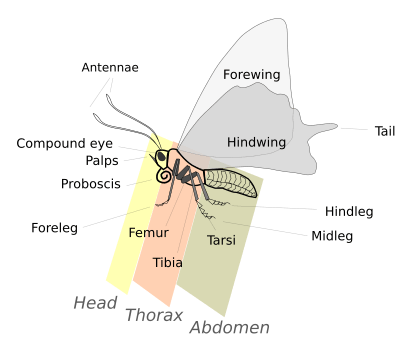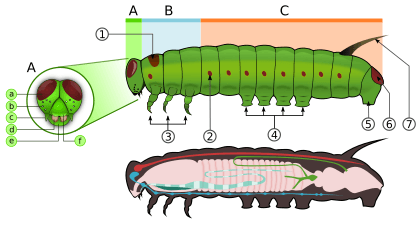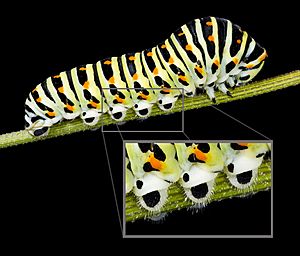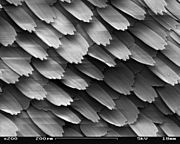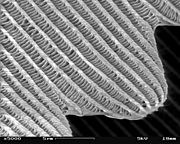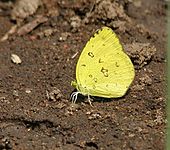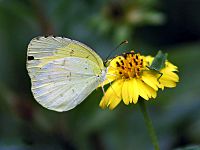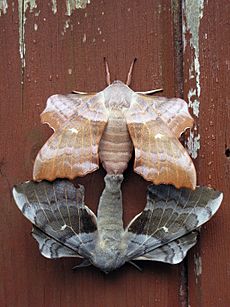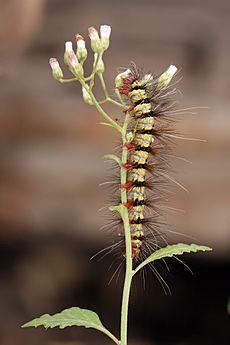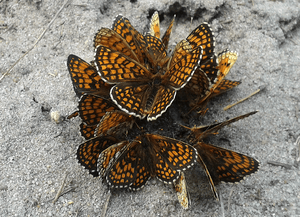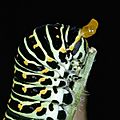Lepidoptera facts for kids
Quick facts for kids Moths and butterflies |
|
|---|---|
 |
|
| The Clipper, Parthenos sylvia (Papilionoidea: Nymphalidae: Limenitidinae) |
|
| Scientific classification | |
| Kingdom: | |
| Phylum: | |
| Class: | |
| Subclass: | |
| Infraclass: | |
| Superorder: | |
| Order: |
Lepidoptera
|
| Suborders | |
|
|
The order Lepidoptera is the second biggest order in the class Insecta. It includes the butterflies, moths and skippers. There is no common word for the group: ordinary people talk of "butterflies and moths". A person who collects or studies this order is called a Lepidopterist.
The order has more than 180,000 species in 128 families and 47 superfamilies. They are 10% of all the described species of living organisms. The order Coleoptera (the beetles) is the only order that has more species.
The name, Lepidoptera, comes from the Ancient Greek words λεπίδος (scale) and πτερόν (wing).
Contents
External morphology
Lepidoptera are morphologically distinguished from other orders principally by the presence of scales on the external parts of the body and appendages, especially the wings. Butterflies and moths vary in size from microlepidoptera only a few millimeters long, to conspicuous animals with a wingspan greater than 25 centimetres, such as the Queen Alexandra's birdwing and Atlas moth. Lepidopterans undergo a four-stage life cycle: egg; larva or caterpillar; pupa or chrysalis; and imago (plural: imagines) / adult and show many variations of the basic body structure, which give these animals advantages for diverse lifestyles and environments.
Head
The head is where many sensing organs and the mouth parts are found. Like the adult, the larva also has a toughened, or sclerotized head capsule. Here, two compound eyes, and chaetosema, raised spots or clusters of sensory bristles unique to Lepidoptera, occur, though many taxa have lost one or both of these spots. The antennae have a wide variation in form among species and even between different sexes. The antennae of butterflies are usually filiform and shaped like clubs, those of the skippers are hooked, while those of moths have flagellar segments variously enlarged or branched. Some moths have enlarged antennae or ones that are tapered and hooked at the ends.
The maxillary galeae are modified and form an elongated proboscis. The proboscis consists of one to five segments, usually kept coiled up under the head by small muscles when it is not being used to suck up nectar from flowers or other liquids. Some basal moths still have mandibles, or separate moving jaws, like their ancestors, and these form the family Micropterigidae.
The larvae, called caterpillars, have a toughened head capsule. Caterpillars lack the proboscis and have separate chewing mouthparts. These mouthparts, called mandibles, are used to chew up the plant matter that the larvae eat. The lower jaw, or labium, is weak, but may carry a spinneret, an organ used to create silk. The head is made of large lateral lobes, each having an ellipse of up to six simple eyes.
Thorax
The thorax is made of three fused segments, the prothorax, mesothorax, and metathorax, each with a pair of legs. The first segment contains the first pair of legs. In some males of the butterfly family Nymphalidae, the forelegs are greatly reduced and are not used for walking or perching. The three pairs of legs are covered with scales. Lepidoptera also have olfactory organs on their feet, which aid the butterfly in "tasting" or "smelling" out its food. In the larval form there are 3 pairs of true legs, with up to 11 pairs of abdominal legs (usually eight) and hooklets, called apical crochets.
The two pairs of wings are found on the middle and third segments, or mesothorax and metathorax, respectively. In the more recent genera, the wings of the second segment are much more pronounced, although some more primitive forms have similarly sized wings of both segments. The wings are covered in scales arranged like shingles, which form an extraordinary variety of colors and patterns. The mesothorax has more powerful muscles to propel the moth or butterfly through the air, with the wing of this segment (forewing) having a stronger vein structure. The largest superfamily, the Noctuidae, has their wings modified to act as tympanal or hearing organs.
The caterpillar has an elongated, soft body that may have hair-like or other projections, three pairs of true legs, with none to 11 pairs of abdominal legs (usually eight) and hooklets, called apical crochets. The thorax usually has a pair of legs on each segment. The thorax is also lined with many spiracles on both the mesothorax and metathorax, except for a few aquatic species, which instead have a form of gills.
Abdomen
The abdomen, which is less sclerotized than the thorax, consists of 10 segments with membranes in between, allowing for articulated movement. The sternum, on the first segment, is small in some families and is completely absent in others. The last two or three segments form the external parts of the species' sex organs. The genitalia of Lepidoptera are highly varied and are often the only means of differentiating between species. Male genitals include a valva, which is usually large, as it is used to grasp the female during mating. Female genitalia include three distinct sections.
The abdomen of the caterpillar has four pairs of prolegs, normally located on the third to sixth segments of the abdomen, and a separate pair of prolegs by the anus, which have a pair of tiny hooks called crotchets. These aid in gripping and walking, especially in species that lack many prolegs (e. g. larvae of Geometridae). In some basal moths, these prolegs may be on every segment of the body, while prolegs may be completely absent in other groups, which are more adapted to boring and living in sand (e. g., Prodoxidae and Nepticulidae, respectively).
Scales
The wings, head, and parts of the thorax and abdomen of Lepidoptera are covered with minute scales, a feature from which the order derives its name. Most scales are lamellar, or blade-like and attached with a pedicel, while other forms may be hair-like or specialized as secondary sexual characteristics.
The lumen or surface of the lamella has a complex structure. It gives color either by colored pigments it contains, or through structural coloration with mechanisms that include photonic crystals and diffraction gratings.
Scales function in insulation, thermoregulation, producing pheromones (in males only), and aiding gliding flight, but the most important is the large diversity of vivid or indistinct patterns they provide, which help the organism protect itself by camouflage or mimicry, and which act as signals to other animals including rivals and potential mates.
Internal morphology
Digestive system
In the digestive system, the anterior region of the foregut has been modified to form a pharyngeal sucking pump as they need it for the food they eat, which are for the most part liquids. An esophagus follows and leads to the posterior of the pharynx and in some species forms a form of crop. The midgut is short and straight, with the hindgut being longer and coiled. Most butterflies and moths display the usual digestive cycle, but species with different diets require adaptations to meet these new demands.
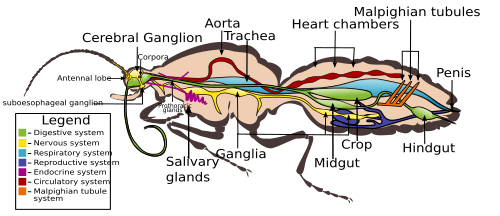
Circulatory system
In the circulatory system, hemolymph, or insect blood, is used to circulate heat in a form of thermoregulation, where muscles contraction produces heat, which is transferred to the rest of the body when conditions are unfavorable. In lepidopteran species, hemolymph is circulated through the veins in the wings by some form of pulsating organ, either by the heart or by the intake of air into the trachea.
Respiratory system
Air is taken in through spiracles along the sides of the abdomen and thorax supplying the trachea with oxygen as it goes through the lepidopteran's respiratory system. Three different tracheaes supply and diffuse oxygen throughout the species' bodies. The dorsal tracheae supply oxygen to the dorsal musculature and vessels, while the ventral tracheae supply the ventral musculature and nerve cord, and the visceral tracheae supply the guts, fat bodies, and gonads.
Polymorphism
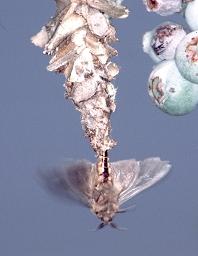
Polymorphism is the appearance of forms or "morphs", which differ in color and number of attributes within a single species. In Lepidoptera, polymorphism can be seen not only between individuals in a population, but also between the sexes as sexual dimorphism, between geographically separated populations in geographical polymorphism, and between generations flying at different seasons of the year (seasonal polymorphism or polyphenism). In some species, the polymorphism is limited to one sex, typically the female. This often includes the phenomenon of mimicry when mimetic morphs fly alongside nonmimetic morphs in a population of a particular species. Polymorphism occurs both at specific level with heritable variation in the overall morphological design of individuals, as well as in certain specific morphological or physiological traits within a species.
Environmental polymorphism, in which traits are not inherited, is often termed as polyphenism, which in Lepidoptera is commonly seen in the form of seasonal morphs, especially in the butterfly families of Nymphalidae and Pieridae. An Old World pierid butterfly, the common grass yellow (Eurema hecabe) has a darker summer adult morph, triggered by a long day exceeding 13 hours in duration, while the shorter diurnal period of 12 hours or less induces a paler morph in the postmonsoon period. Polyphenism also occurs in caterpillars, an example being the peppered moth, Biston betularia.
Geographical isolation causes a divergence of a species into different morphs. A good example is the Indian white admiral Limenitis procris, which has five forms, each geographically separated from the other by large mountain ranges. An even more dramatic showcase of geographical polymorphism is the Apollo butterfly (Parnassius apollo). Because the Apollos live in small local populations, thus having no contact with each other, coupled with their strong stenotopic nature and weak migration ability, interbreeding between populations of one species practically does not occur; by this, they form over 600 different morphs, with the size of spots on the wings of which varies greatly.
Sexual dimorphism is the occurrence of differences between males and females in a species. In Lepidoptera, it is widespread and almost completely set by genetic determination. Sexual dimorphism is present in all families of the Papilionoidea and more prominent in the Lycaenidae, Pieridae, and certain taxa of the Nymphalidae. Apart from color variation, which may differ from slight to completely different color-pattern combinations, secondary sexual characteristics may also be present. Different genotypes maintained by natural selection may also be expressed at the same time. Polymorphic and/or mimetic females occur in the case of some taxa in the Papilionidae primarily to obtain a level of protection not available to the male of their species. The most distinct case of sexual dimorphism is that of adult females of many Psychidae species which have only vestigial wings, legs, and mouthparts as compared to the adult males that are strong fliers with well-developed wings and feathery antennae.
Reproduction and development
Species of Lepidoptera undergo holometabolism or "complete metamorphosis". Their life cycle normally consists of an egg, a larva, a pupa, and an imago or adult. The larvae are commonly called caterpillars, and the pupae of moths encapsulated in silk are called cocoons, while the uncovered pupae of butterflies are called chrysalides.
.
Life cycle
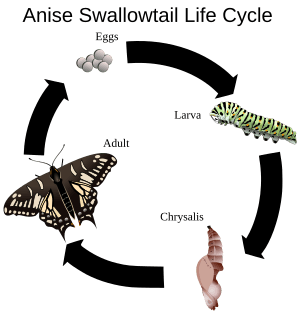
Eggs
Lepidoptera usually reproduce sexually and are oviparous (egg-laying), though some species exhibit live birth in a process called ovoviviparity. A variety of differences in egg-laying and the number of eggs laid occur. Some species simply drop their eggs in flight (these species normally have polyphagous larvae, meaning they eat a variety of plants e. g., hepialids and some nymphalids) while most lay their eggs near or on the host plant on which the larvae feed. The number of eggs laid may vary from only a few to several thousand. The females of both butterflies and moths select the host plant instinctively, and primarily, by chemical cues.
The eggs are derived from materials ingested as a larva and in some species, from the spermatophores received from males during mating. An egg can only be 1/1000 the mass of the female, yet she may lay up to her own mass in eggs. Females lay smaller eggs as they age. Larger females lay larger eggs. The egg is covered by a hard-ridged protective outer layer of shell, called the chorion. It is lined with a thin coating of wax, which prevents the egg from drying out. Each egg contains a number of micropyles, or tiny funnel-shaped openings at one end, the purpose of which is to allow sperm to enter and fertilize the egg. Butterfly and moth eggs vary greatly in size between species, but they are all either spherical or ovate.
The egg stage lasts a few weeks in most butterflies, but eggs laid prior to winter, especially in temperate regions, go through diapause, and hatching may be delayed until spring. Other butterflies may lay their eggs in the spring and have them hatch in the summer. These butterflies are usually temperate species (e. g. Nymphalis antiopa).
Larvae
The larvae or caterpillars are the first stage in the life cycle after hatching. Caterpillars, are "characteristic polypod larvae with cylindrical bodies, short thoracic legs, and abdominal prolegs (pseudopods)". They have a toughened (sclerotised) head capsule with an adfrontal suture formed by medial fusion of the sclerites, mandibles (mouthparts) for chewing, and a soft tubular, segmented body, that may have hair-like or other projections, three pairs of true legs, and additional prolegs (up to five pairs). The body consists of thirteen segments, of which three are thoracic and ten are abdominal. Most larvae are herbivores, but a few are carnivores (some eat ants or other caterpillars) and detritivores.
Different herbivorous species have adapted to feed on every part of the plant and are normally considered pests to their host plants; some species have been found to lay their eggs on the fruit and other species lay their eggs on clothing or fur (e. g., Tineola bisselliella, the common clothes moth). Some species are carnivorous and others are even parasitic. Some lycaenid species such as Maculinea rebeli are social parasites of Myrmica ants nests. A species of Geometridae from Hawaii has carnivorous larvae that catch and eat flies. Some pyralid caterpillars are aquatic.
The larvae develop rapidly with several generations in a year; however, some species may take up to 3 years to develop, and exceptional examples like Gynaephora groenlandica take as long as seven years. The larval stage is where the feeding and growing stages occur, and the larvae periodically undergo hormone-induced ecdysis, developing further with each instar, until they undergo the final larval-pupal molt.
The larvae of both butterflies and moths exhibit mimicry to deter potential predators. Some caterpillars have the ability to inflate parts of their heads to appear snake-like. Many have false eye-spots to enhance this effect. Some caterpillars have special structures called osmeteria (family Papilionidae), which are exposed to produce smelly chemicals used in defense. Host plants often have toxic substances in them and caterpillars are able to sequester these substances and retain them into the adult stage. This helps make them unpalatable to birds and other predators. Such unpalatability is advertised using bright red, orange, black, or white warning colors. The toxic chemicals in plants are often evolved specifically to prevent them from being eaten by insects. Insects, in turn, develop countermeasures or make use of these toxins for their own survival. This "arms race" has led to the coevolution of insects and their host plants.
Wing development
No form of wing is externally visible on the larva, but when larvae are dissected, developing wings can be seen as disks, which can be found on the second and third thoracic segments, in place of the spiracles that are apparent on abdominal segments. Wing disks develop in association with a trachea that runs along the base of the wing, and are surrounded by a thin peripodial membrane, which is linked to the outer epidermis of the larva by a tiny duct. Wing disks are very small until the last larval instar, when they increase dramatically in size, are invaded by branching tracheae from the wing base that precede the formation of the wing veins, and begin to develop patterns associated with several landmarks of the wing.
Near pupation, the wings are forced outside the epidermis under pressure from the hemolymph, and although they are initially quite flexible and fragile, by the time the pupa breaks free of the larval cuticle, they have adhered tightly to the outer cuticle of the pupa (in obtect pupae). Within hours, the wings form a cuticle so hard and well-joined to the body that pupae can be picked up and handled without damage to the wings.
Pupa
After about five to seven instars, or molts, certain hormones, like PTTH, stimulate the production of ecdysone, which initiates insect molting. Then, the larva puparium, a sclerotized or hardened cuticle of the last larval instar, develops into the pupa. Depending on the species, the pupa may be covered in a silk cocoon, attached to different types of substrates, buried in the ground, or may not be covered at all. Features of the imago are externally recognizable in the pupa. All the appendages on the adult head and thorax are found cased inside the cuticle (antennae, mouthparts, etc.), with the wings wrapped around, adjacent to the antennae. The pupae of some species have functional mandibles, while the pupal mandibles are not functional in others.
While encased, some of the lower segments are not fused, and are able to move using small muscles found in between the membrane. Moving may help the pupa, for example, escape the sun, which would otherwise kill it. The pupa of the Mexican jumping bean moth (Cydia deshaisiana) does this. The larvae cut a trapdoor in the bean (species of Sebastiania) and use the bean as a shelter. With a sudden rise in temperature, the pupa inside twitches and jerks, pulling on the threads inside. Wiggling may also help to deter parasitoid wasps from laying eggs on the pupa. Other species of moths are able to make clicks to deter predators.
The length of time before the pupa ecloses (emerges) varies greatly. The monarch butterfly may stay in its chrysalis for two weeks, while other species may need to stay for more than 10 months in diapause. The adult emerges from the pupa either by using abdominal hooks or from projections located on the head. The mandibles found in the most primitive moth families are used to escape from their cocoon (e. g., Micropterigoidea).
Adult
Most lepidopteran species do not live long after eclosion, only needing a few days to find a mate and then lay their eggs. Others may remain active for a longer period (from one to several weeks), or go through diapause and overwintering as monarch butterflies do, or waiting out environmental stress. Some adult species of microlepidoptera go through a stage where no reproductive-related activity occurs, lasting through summer and winter, followed by mating and oviposition in the early spring.
While most butterflies and moths are terrestrial, many species of Pyralidae are truly aquatic with all stages except the adult occurring in water. Many species from other families such as Arctiidae, Nepticulidae, Cosmopterygidae, Tortricidae, Olethreutidae, Noctuidae, Cossidae, and Sphingidae are aquatic or semiaquatic.
Behavior
Flight
Flight is an important aspect of the lives of butterflies and moths, and is used for evading predators, searching for food, and finding mates in a timely manner, as lepidopteran species do not live long after eclosion. It is the main form of locomotion in most species. In Lepidoptera, the forewings and hindwings are mechanically coupled and flap in synchrony. Flight is anteromotoric, or being driven primarily by action of the forewings. Although lepidopteran species reportedly can still fly when their hindwings are cut off, it reduces their linear flight and turning capabilities.
Lepidopteran species have to be warm, about 77 to 79 °F (25 to 26 °C), to fly. They depend on their body temperature being sufficiently high and since they cannot regulate it themselves, this is dependent on their environment. Butterflies living in cooler climates may use their wings to warm their bodies. They will bask in the sun, spreading out their wings so that they get maximum exposure to the sunlight. In hotter climates butterflies can easily overheat, so they are usually active only during the cooler parts of the day, early morning, late afternoon or early evening. During the heat of the day, they rest in the shade. Some larger thick-bodied moths (e.g. Sphingidae) can generate their own heat to a limited degree by vibrating their wings. The heat generated by the flight muscles warms the thorax while the temperature of the abdomen is unimportant for flight. To avoid overheating, some moths rely on hairy scales, internal air sacs, and other structures to separate the thorax and abdomen and keep the abdomen cooler.
Some species of butterflies can reach fast speeds, such as the southern dart, which can go as fast as 48.4 km/h. Sphingids are some of the fastest flying insects, some are capable of flying at over 50 km/h (30 mi/h), having a wingspan of 35–150 mm. In some species, sometimes a gliding component to their flight exists. Flight occurs either as hovering, or as forward or backward motion. In butterfly and moth species, such as hawk moths, hovering is important as they need to maintain a certain stability over flowers when feeding on the nectar.
Navigation is important to Lepidoptera species, especially for those that migrate. Butterflies, which have more species that migrate, have been shown to navigate using time-compensated sun compasses. They can see polarized light, so can orient even in cloudy conditions. The polarized light in the region close to the ultraviolet spectrum is suggested to be particularly important. Most migratory butterflies are those that live in semiarid areas where breeding seasons are short. The life histories of their host plants also influence the strategies of the butterflies. Other theories include the use of landscapes. Lepidoptera may use coastal lines, mountains, and even roads to orient themselves. Above sea, the flight direction is much more accurate if the coast is still visible.
Many studies have also shown that moths navigate. One study showed that many moths may use the Earth's magnetic field to navigate, as a study of the moth heart and dart suggests. Another study, of the migratory behavior of the silver Y, showed, even at high altitudes, the species can correct its course with changing winds, and prefers flying with favourable winds, suggesting a great sense of direction. Aphrissa statira in Panama loses its navigational capacity when exposed to a magnetic field, suggesting it uses the Earth's magnetic field.
Moths exhibit a tendency to circle artificial lights repeatedly. This suggests they use a technique of celestial navigation called transverse orientation. By maintaining a constant angular relationship to a bright celestial light, such as the Moon, they can fly in a straight line. Celestial objects are so far away, even after traveling great distances, the change in angle between the moth and the light source is negligible; further, the moon will always be in the upper part of the visual field or on the horizon. When a moth encounters a much closer artificial light and uses it for navigation, the angle changes noticeably after only a short distance, in addition to being often below the horizon. The moth instinctively attempts to correct by turning toward the light, causing airborne moths to come plummeting downwards, and at close range, which results in a spiral flight path that gets closer and closer to the light source. Other explanations have been suggested, such as the idea that moths may be impaired with a visual distortion called a Mach band by Henry Hsiao in 1972. He stated that they fly towards the darkest part of the sky in pursuit of safety, thus are inclined to circle ambient objects in the Mach band region.
Migration
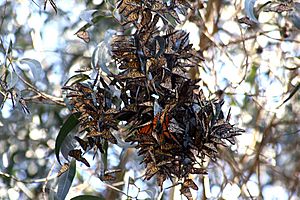
Lepidopteran migration is typically seasonal, as the insects moving to escape dry seasons or other disadvantageous conditions. Most lepidopterans that migrate are butterflies, and the distance travelled varies. Some butterflies that migrate include the mourning cloak, painted lady, American lady, red admiral, and the common buckeye. A notable species of moth that migrates long distances is the bogong moth. The most well-known migrations are those of the eastern population of the monarch butterfly from Mexico to northern United States and southern Canada, a distance of about 4,000–4,800 km (2,500–3,000 mi). Other well-known migratory species include the painted lady and several of the danaine butterflies. Spectacular and large-scale migrations associated with the monsoons are seen in peninsular India. Migrations have been studied in more recent times using wing tags and stable hydrogen isotopes.
Moths also undertake migrations, an example being the uraniids. Urania fulgens undergoes population explosions and massive migrations that may be not surpassed by any other insect in the Neotropics. In Costa Rica and Panama, the first population movements may begin in July and early August and depending on the year, may be very massive, continuing unabated for as long as five months.
Communication
Pheromones are commonly involved in mating rituals among species, especially moths, but they are also an important aspect of other forms of communication. Usually, the pheromones are produced by either the male or the female and detected by members of the opposite sex with their antennae. In many species, a gland between the eighth and ninth segments under the abdomen in the female produces the pheromones. Communication can also occur through stridulation, or producing sounds by rubbing various parts of the body together.
Moths are known to engage in acoustic forms of communication, most often as courtship, attracting mates using sound or vibration. Like most other insects, moths pick up these sounds using tympanic membranes in their abdomens. An example is that of the polka-dot wasp moth (Syntomeida epilais), which produces sounds with a frequency above that normally detectable by humans (about 20 kHz). These sounds also function as tactile communication, or communication through touch, as they stridulate, or vibrate a substrate like leaves and stems.
Most moths lack bright colors, as many species use coloration as camouflage, but butterflies engage in visual communication. Female cabbage butterflies, for example, use ultraviolet light to communicate, with scales colored in this range on the dorsal wing surface. When they fly, each down stroke of the wing creates a brief flash of ultraviolet light which the males apparently recognize as the flight signature of a potential mate. These flashes from the wings may attract several males that engage in aerial courtship displays.
Images for kids
-
A day-flying hummingbird hawk-moth drinking nectar from a species of Dianthus
-
Tobacco hornworm caterpillar (Manduca sexta) parasitized by Braconidae wasp larvae
-
Lepidoptera collection in Cherni Osam Natural Sciences Museum, Troyan, Bulgaria
-
1887 engraving of Prodryas persephone, a fossil lepidopteran from the Eocene.
-
Death's-head hawkmoth (Acherontia lachesis), an old bleached specimen still showing the classical skull pattern on the thorax
See also
 In Spanish: Lepidópteros para niños
In Spanish: Lepidópteros para niños


